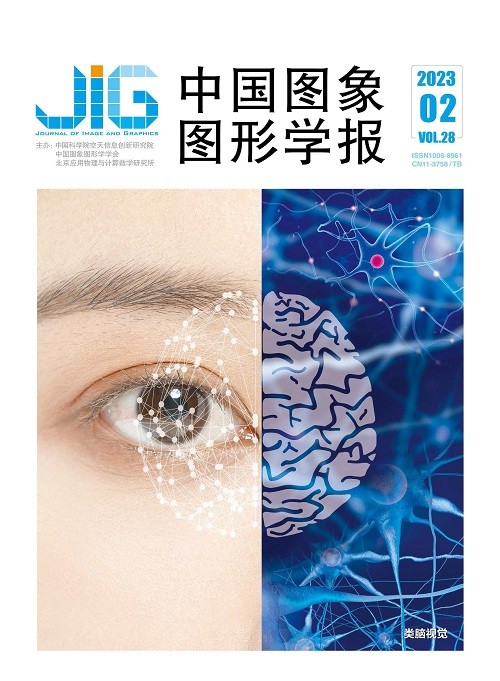
面向脑核磁共振识别运动任务的门控循环单元方法
摘 要
目的 在脑科学领域,已有研究借助脑功能核磁共振影像数据(functional magnetic resonance imaging,fMRI)探索和区分人类大脑在不同运动任务下的状态,然而传统方法没有充分利用fMRI数据的时序特性。对此,本文提出基于fMRI数据计算的全脑脑区时间信号(time course,TC)的门控循环单元(gated recurrent unit,GRU)方法(TC-GRU)进行运动任务分类。方法 基于HCP (human connectome project)数据集中的100个健康被试者在5种运动任务中分两轮采集的1 000条fMRI数据,对每种运动任务计算每个被试者在各脑区(共360个脑区)的时间信号;使用10折交叉验证方案基于训练集和验证集训练TC-GRU模型,并用构建好的模型对测试集进行测试,考察其对5种运动任务的分类能力,其中TC-GRU在各时刻的输入特征为全脑脑区在对应时刻的TC信号幅值,通过这样的方式提取全脑脑区在整个时间段的时序特征。同时,为了展示使用TC-GRU模型可挖掘fMRI数据中更丰富的信息,设计了多个对比实验进行比较,利用长短期记忆网络(long short-term memory,LSTM)、图卷积网络(graph convolutional network,GCN)和多层感知器(multi-layer perceptron,MLP)基于全脑脑区时间信号进行运动任务分类,以及利用MLP基于由fMRI数据估计的脑功能连接进行运动任务分类。此外,考察了先验的特征选择对分类效果的效应。结果 基于全脑脑区时间信号的TC-GRU模型在运动任务中的分类准确率最高,为94.51%±2.4%,其次是基于全脑脑区时间信号的LSTM模型,准确率为93.73%±2.67%。基于全脑脑区时间信号利用MLP进行分类,有先验和无先验的特征选择准确率分别为92.75%±2.59%和92.04%±7.15%,比基于全脑脑区时间信号的GCN (准确率为87.14%±3.73%)和基于脑功能连接利用MLP进行分类(有先验和无先验的特征选择准确率分别为72.47%±4.47%和61.49%±9.97%)表现更好。结论 TC-GRU模型可挖掘脑fMRI数据中丰富的时序信息,非常有效地对不同的运动任务进行分类。
关键词
Gated recurrent unit method for motor tasks recognition using brain fMRI
Yuan Zhen, Hou Yuliang, Du Yuhui(School of Computer and Information Technology, Shanxi University, Taiyuan 030006, China) Abstract
Objective In the field of neuroscience, there have been studies using functional magnetic resonance imaging (fMRI) data to explore functions of the human brain and distinguish its states under different motor tasks. However, previous studies that focused on the brain state classification using task fMRI did not make full use of temporal characteristics of fMRI data. Here, we propose a method (named TC-GRU) that employs gated recurrent unit (GRU) to capture fine-grained features from time courses (TC) of whole-brain regions estimated from fMRI data for the classification of motor tasks. Method The fMRI data are gathered from 100 healthy subjects in the human connectome project (HCP) under 5 body-motion tasks (including left hand, right hand, left foot, right foot, and tongue motor) with 2 scanning operations, resulting in 1 000 samples for classifying the 5 motor tasks. First, for each sample, we calculate the average fMRI TC for each brain region as the representative TC of the brain region. The whole brain is divided into 360 brain regions according to the Glasser brain template. Then, using a 10-fold cross-validation framework (8:1:1 for the training set, the validation set, and the testing set) with 100 repetitions, the TC-GRU model is trained and optimized based on the training set and the validation set, and the model-trained is further applied to the testing set to examine its ability in classifying this 5 body motor tasks. In our TC-GRU model, the GRU is used to extract the temporal features in the TCs of the brain regions, and a linear classifier is used for classification based on the temporal features. Specifically, at a certain moment, the inputs of the GRU model are the TC amplitudes of the whole-brain regions at that moment as well as the temporal features of the past moments captured by the GRU model, and the GRU model fuses the inputs and produces the temporal features at the current time. This process continues until the last moment to generate temporal features for the classification. In our work, we also compare the most state-of-the-art methods with the TC-GRU. The long short-term memory (LSTM), graph convolutional network (GCN), and multi-layer perceptron (MLP) are used to classify the motor tasks based on TCs of whole-brain regions as well as brain functional connectivity measures estimated by the fMRI data. Furthermore, we examine the effects of prior feature selection and no feature selection on the classification performance. It is noteworthy that a consistent 10-fold cross-validation framework is used for multiple methods and the overall classification accuracy is summarized through 100 cross-validation tests. The overall classification accuracy is the mean classification accuracy, and the performance stability is reflected by the standard deviation of the classification accuracy. Result The highest ranking of the classification accuracy (accuracy:94.51%±2.4%) can be achieved via the TC-GRU method, and the second rank is the LSTM using TC information (accuracy:93.73%±2.67%). Using MLP based on the TCs of whole-brain regions (accuracy from the experiments with prior feature selection and without prior feature selection is 92.75%±2.59% and 92.04%±7.15%, respectively) is better than using GCN (accuracy:87.14%±3.73%) based on the TCs of whole-brain regions and MLP based on the brain functional connectivity measures (accuracy from experiments with prior feature selection and without prior feature selection is 72.47%±4.47% and 61.49%±9.97%, respectively). Conclusion To the best of our knowledge, this paper is the first time to distinguish different human brain motor tasks using GRU based on time courses of the whole-brain regions. Our results support that the TC-GRU method outperforms six state-of-the-art methods on human brain motor task classification because that the TC-GRU can mine more useful information in the brain fMRI data. In summary, our finding suggests the importance of utilizing temporal information of fMRI data to decode the complex brain.
Keywords
brain functional magnetic resonance imaging whole-brain time courses functional connectivity gated recurrent unit (GRU) multi-layer perceptron(MLP) motor task classification
|



 中国图象图形学报 │ 京ICP备05080539号-4 │ 本系统由
中国图象图形学报 │ 京ICP备05080539号-4 │ 本系统由